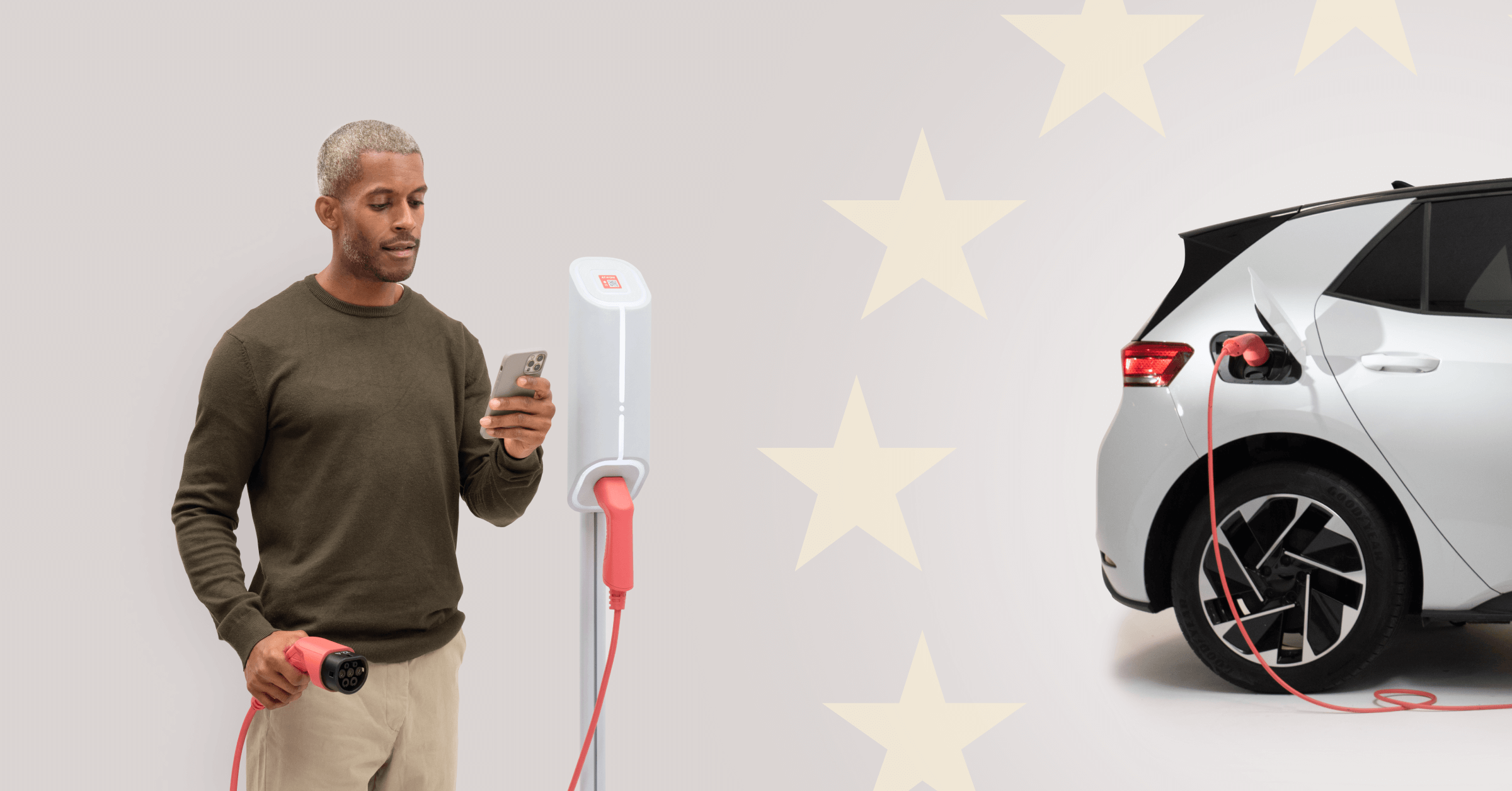
When a fast-developing industry like electric mobility hits a new milestone – such as the soon-to-be implemented Alternative Fuels Infrastructure Regulation (or AFIR) – it gives us a chance to look back on where we’ve come from, as well as validate the road we’re on together: the journey towards an electronically powered future that’s much more sustainable and eco-friendly than what we have today.
But even though we’ve come a long way, there’s still some work that needs to be done. Which is the primary reason for the European Parliament developing AFIR in the first place – as a response to the uneven development of EV charging infrastructure across the European Union today. While EV adoption is rising rapidly (as is the development of EV technology), on an international level, the lack of infrastructure, interoperability issues and absence of common standards have resulted in an uncertain environment for EV charging. And this needs to change, especially in light of the EU’s 2050 climate neutrality goal.
This is where AFIR comes in. Part of the EU’s “Fit for 55” policy package, AFIR will officially come into effect on April 13, 2024, establishing a new framework for deploying alternative fuel infrastructure – with a special focus on road transport and electricity-powered vehicles.
Why is this important? Because from now on, AFIR mandates that all newly established public charging stations need to comply with its requirements for pricing, payment, billing, interoperability and third-party data sharing. For charge point operators in the EU market, it’s understandably essential to see just what these requirements are, and how they affect future (or already existing) charge point networks to make sure they’re fully compliant with AFIR’s new conditions.
Which is why we’ve prepared this short overview of AFIR’s key highlights, its most relevant aspects for charge point operations and the predicted impact on the EV charging ecosystem. You’ll also find out how we can support your EV charging business with effortless payments through our ingenious Monta product suite – with solutions that both speed up and simplify your AFIR compliance if needed.
Pricing and payment options at charge points
The most pertinent requirements in AFIR – at least when it comes to charge point operators and their business – are those which describe a consolidated EU standard for pricing and payment options, which EV drivers can use at all publicly accessible recharging points. These centre around two major concepts: transparent pricing at every charge point, and providing ad-hoc payment options after every charge.
The overall goal for both is the same: AFIR aims to address EV drivers’ concerns about variable tariffs and unforeseen charging costs with these newly introduced stipulations. However, this doesn’t mean charge point operators will have no say in their own pricing structures: as long as you are transparent and reasonable in your pricing variation, you will be compliant with AFIR. You’ll even have the ability to apply additional fees, in order to discourage prolonged occupancy of charging-designated parking spots after charging – as long as there’s clear indication of all such fees and the potential for per-minute charges.
Transparent EV charging prices for all drivers
According to AFIR , the price for an EV charging session should be transparent, easily comparable and clearly communicated to the EV driver before the start of each charging session. AFIR also stipulates that EV charging prices must be reasonable and non-discriminatory – meaning that, while pricing levels can still differ between users, any and all changes should be proportionate and objectively justified.
To increase transparency, it will be a requirement on DC charging stations that the price per kWh for the electricity delivered is shown physically. This price must be shown based on the price per kWh and, if applicable, an occupancy fee based on a price per minute.
For AC chargers, it will be sufficient that pricing is transparently disclosed in an app, and more price components are allowed, however it is a requirement that the following price components should always be shown clearly (and in this specific order):
- price per kWh
- price per minute
- price per session, and lastly
- any other price component that applies.
Create transparent pricing and stay compliant – together with Monta
Here at Monta, we help charge point operators stay ahead in the ever-evolving EV charging ecosystem with solutions specially designed to provide pricing transparency for your customers – all while staying compliant with AFIR regulations.
With our Dynamic Pricing feature, you can easily align your charge rates with the fluctuating electricity market prices – which will not only cover your operational costs, but also ensure fair pricing for all EV drivers using your charge points. As charge point operators, you’ll gain the ability to transparently communicate your pricing strategies and expected margins; meanwhile, EV drivers charging with your will benefit from seeing price trends clearly, enabling them to schedule charging during cheaper rates with our Monta Charge app.

And if you’re a charge point operator without fixed grid tariffs? Our Tariff Creator tool lets you customise and manage time-based tariffs to suit all various needs and grid arrangements across Europe. This flexibility allows you to set competitive prices seasonally, weekly or hourly – catering to high, medium, and low demand periods, and ensuring diverse and adaptable pricing for every situation.
Ad-hoc payment options at all charge points
AFIR also states that European operators of public charging stations need to offer ad-hoc charging options using widely accepted payment instruments for all charge points deployed after April 13, 2024. The reason for this, according to AFIR, is that all EV drivers should be able to access charging services conveniently, without needing a subscription. This new regulation enables roaming EV drivers (or those who opt not to be tied to a single provider) to pay directly at the charger using debit or credit cards.
AFIR specifies that DC charging stations deployed after 13 April 2024 must include payment terminals. There are several options: instead of a built-in card terminal, stations may use standalone payment terminals. And fortunately, the regulation sets out that one central payment terminal may manage multiple charging points at one location, streamlining costs for operators – particularly in larger parking areas or charging parks.
For AC charge points deployed after 13 April 2024 other secure payment methods such as the use of QR codes are allowed. Hence, operators of AC charge points can make their own choice between offering payment via a payment terminal or the use of QR codes.
Regardless of AC or DC charging, the main goal remains the same: enhancing accessibility for all EV drivers with the ability to charge “ad hoc” in order to standardise and ease the complex EV charging market meanwhile minimising the risk of fraud.
Broaden your range of payment options with Monta
We’re happy to offer you multiple charging payment options here at Monta, all of which are easily customisable to different countries and services – making sure each journey is more accessible and enjoyable than the one before! Drivers can easily pay for charging their EVs with our flexible payment options; and as a charge point operator, you can seamlessly connect your payment terminal with any Monta-compatible charger through Monta Hub. (We also offer payments through QR codes on AC chargers.)

Upcoming infrastructure and accessibility developments
Payment options and transparent pricing are certainly a cornerstone of AFIR’s new stipulations – however, there are also other aspects related to electronic mobility that pertain to your business as a charge point operator. The two most important of which are the development of EV charging infrastructures in Europe, and the importance of accessibility for all EV drivers.
Expansion of charging infrastructure in Europe
To combat the (currently) fragmented charging infrastructure in Europe’s busiest international routes, AFIR has proposed a detailed plan for all EU member states to install new charging points, so we can better keep up with the increasing electrification of the continent’s car fleet.
Here are a few highlights from this plan:
- From 2025, all EU member states will have to provide access to a fast-charging station (i.e. at least 150 kW) every 60 kilometres along the trans-European transport network (TEN-T).
- A charging capacity of at least 1.3 kW must be provided for each battery-electric car registered in a member state (0.50 kW for plug-in hybrid vehicles).
- Charging stations along major roads must be installed within 3 km of the nearest exit.
- Recharging stations for heavy-duty vehicles (featuring a minimum output of 350kW) must be deployed every 60 km along the TEN-T core network, and every 100 km on the larger TEN-T comprehensive network. This initiative is supposed to start deployment in 2025, with full network coverage by 2030.
- Hydrogen refuelling stations catering to both cars and lorries are mandated from 2030 onwards at all urban nodes, and every 200 km along the TEN-T core network.
As more and more charge points are required by AFIR on an international level, this is fast becoming a great opportunity for charge point operators to grow their networks. But it’s also important for you to make sure that your charge points are both found by EV drivers and used as much as possible. As an EV charge point operator, you probably have first-hand knowledge of the challenge to keep your charging stations fully utilised.
Even if you have a steady stream of local EV drivers using your charge points, there may be periods of low usage due to factors like the time of day, the weather, or simply the lack of EVs in the area. At Monta, we support charge point operators in the dynamic EV charging industry through Monta’s Roaming network, helping you improve the utilisation of your charge points and tap into Europe’s fastest-growing EV community. As of now, we have more than 500K charge points in our ever-growing network – and more than 1 million EV drivers using our Monta Charge app to find charging stations when they’re on the road.
Charge point accessibility for all EV drivers
One last (but no less essential) point in AFIR states that EV charging infrastructure must always be made accessible to people with reduced mobility. This means that charging station designs now need to include provisions for sufficient space, appropriate height of buttons, easy handling of charging cables, emergency buttons and adequate lighting – to name just a few.
One less thought-of result of this initiative is that charge point operators of publicly accessible recharging points are now responsible for all their direct current (DC) publicly accessible charging points having a fixed recharging cable installed. This might sound like a hassle at first, but we have some good news: at Monta, we are compatible with DC chargers that allow cable lock directly from the Monta Hub. Which means that you can provide cables to all your compatible DC chargers and ensure that the cable is locked in and available for charging in the fastest way imaginable!
(Already a Monta user? Check this help centre guide for ideas on how to do it!)
Want to become AFIR-compliant? Monta can help you.
New frameworks, initiatives, guidelines… Whatever we call them, they’re important to our industry. However, they also hold their own set of challenges – especially if we want to adapt to them quickly. Here at Monta, we’re ready to assist all EU charge point operators in navigating the changes AFIR proposes. Our solutions for charge point operators are designed for ease of integration and enhanced operational efficiency, guaranteeing a seamless transition to a compliant EV charging network.
Want to find out more about AFIR – or would you just like to discuss how we can support your specific needs? Get in touch with us today, so we can take the first step towards adapting to this evolving landscape together!
- SEO Powered Content & PR Distribution. Get Amplified Today.
- PlatoData.Network Vertical Generative Ai. Empower Yourself. Access Here.
- PlatoAiStream. Web3 Intelligence. Knowledge Amplified. Access Here.
- PlatoESG. Carbon, CleanTech, Energy, Environment, Solar, Waste Management. Access Here.
- PlatoHealth. Biotech and Clinical Trials Intelligence. Access Here.
- Source: https://monta.com/uk/blog/how-afir-regulations-impact-charge-point-operators-in-2024/
